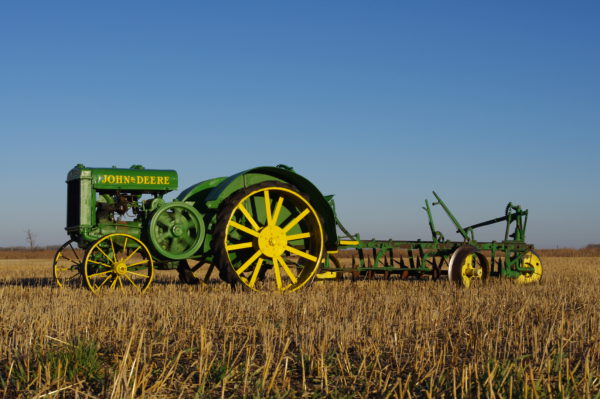
The 1925 John Deere Model D tractor was donated to the museum in 1961 by Dan Campbell of Chater, Manitoba. Mr. Campbell purchased it used in 1927 from the John Deere dealer in Brandon. When the tractor was new, it had been purchased by a farmer at Alexander, Manitoba.
The tractor was used for field work on the Campbell farm such as plowing and harrowing however draft horses were still used for other work such as seeding. cutting hay and so on. Dan Campbell, along with his brothers who also farmed in the Chater area, operated a steam threshing outfit until 1939. After that date, Dan operated his own threshing machine, a 24-inch Woods Brothers machine using the D to power it. In 1942, the tractor was rebuilt with a newer block featuring 6.75-inch diameter cylinders, new rings and valves. The tractor from the factory came with a 6.5-inch bore block. The orginal Dixie magneto was replaced with a Wico magneto as the Dixie was worn out. In 1947, Mr. Campbell purchased a new D and the 1925 D was relegated to secondary duties such as harrowing and belt work. By 1957, the tractor was not in use on the farm. After a period of inactivity, it was donated by Mr. Campbell who was involved with the Manitoba Agricultural Museum almost from the very start. He served as Director in 1953.
John Deere Ds were manufactured from 1923 to 1953 with production totalling 159,083. Over the course of production various changes and updates were made. The first Ds came equipped with an open spoke flywheel and these early tractors came to be known as “spoker” Ds. By 1925 solid “disc” flywheels were being installed as the spoked flywheels were prone to cracking. As production of Ds continued, improvements were made such as power take offs, an updated transmission with three forward speeds instead of the orginal two, rubber tires, oil filters and updated steering gear. In 1939 John Deere introduced styled bodywork and fenders which made the later Ds look significantly different from the unstyled Ds. However under the tin, they were largely the same from a mechanical point of view. The last Ds built could be ordered with electric starting, electric lights and hydraulics.
A visitor can easily track these changes as the museum has a number of Ds in its collections. A visitor can easily compare Ds to see the changes made over the years the tractor was in production.
To complete the comparison a visitor can examine the two Waterloo Boy tractors in the museum’s collections. The Waterloo Gasoline Engine Company which built the Waterloo Boy was purchased by John Deere in 1918. Waterloo Boy production continued until 1923; however, by that time the design was getting rather dated. John Deere discovered after its purchase of the Waterloo Gasoline Engine Company, that the company was experimenting with a new tractor design that used the basic engine design used by the Waterloo Boy tractors combined with a cast iron “bathtub” enclosing the transmission with the final drive. John Deere continued development of this design which finally resulted in the Model D design. When one examines the 1925 D, one will notice that the transmission top is cast iron with the words “Waterloo Gasoline Engine Co. Waterloo Iowa, U.S.A.” cast into the top.
Page revised: 7 December 2022


